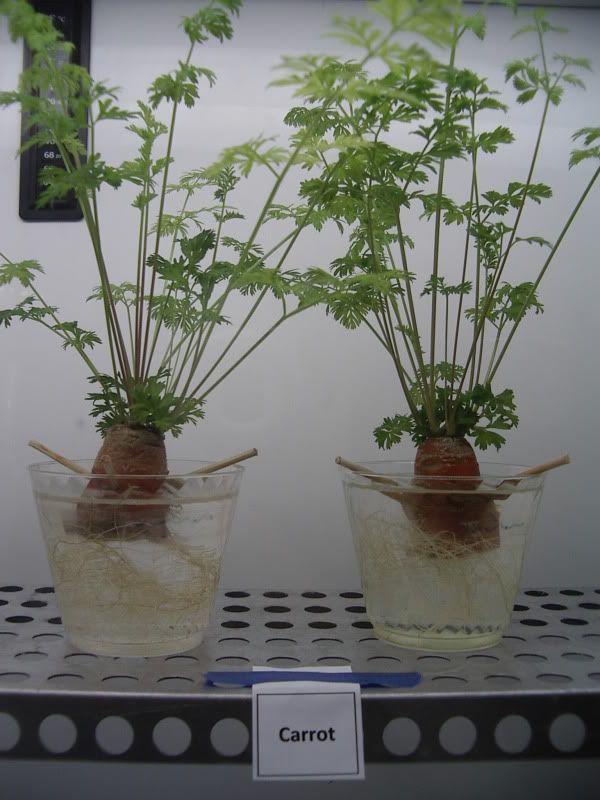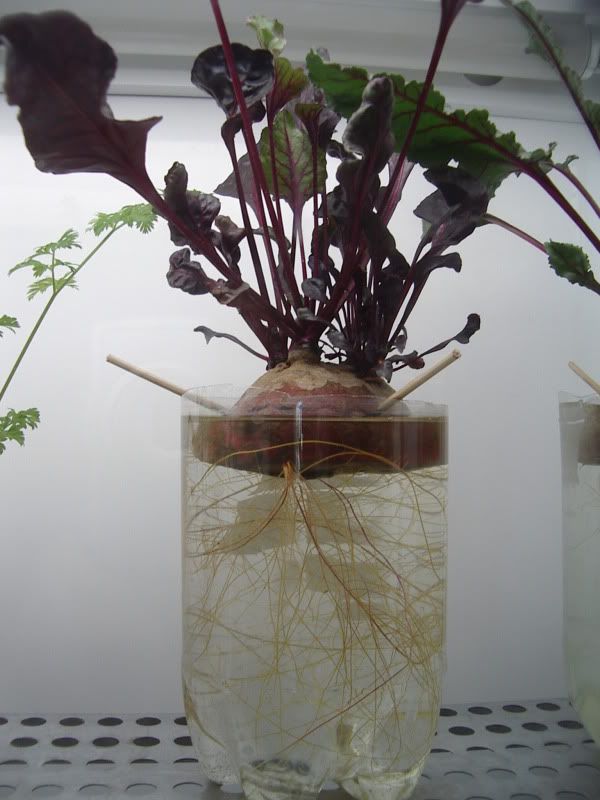Imagine for a moment that you've bought some carrots at the supermarket to make pot pies. Most of the carrot, of course, gets diced up, cooked, and eaten. If you're a gardener then the peelings should already be headed to you compost pile to be broken down into good stuff for your plants. But if you really want to squeeze a little more usefulness out of that carrot, perhaps you can save the top and grow a whole new carrot!
This is a prime example of why I am, perhaps more than any other adjective, a frugal gardener. Anything that I can acquire, repurpose, or make for free I will.
I remember first coming across this notion in an old children's book of projects*. It suggested using both carrot tops in a tray of water and a sweet potato suspended in a glass to grow an indoor jungle. I must have tried the carrot-in-a-tray idea a dozen times growing up but it never worked for me. Usually the carrot dried out and the cat was blamed for drinking all the water.
Now, however, I can now report some success! In January I set up an experiment at a local children's museum to see if the tops of carrots (and some other, similarly structured vegetables) would grow in glasses of water. All the samples were prepared similarly, with most of the root and any leaves removed before being suspended in a glass of water. The water was refilled as needed and completely changed a couple of times a week. Here are the results so far!
The carrots seem to be preforming best. As seen in the photo, both carrots have lots of leaves and roots filling their cups. It is important to note that the carrots in a manner very different to the other samples. They produced roots fairly quickly (a week or two, I believe) but didn't put out any leaves for at least a month.
One of the two radishes is doing well. It produced new leaves quickly, followed by root growth. The other radish reportedly turned to goo within a week and was thrown out.
Only one of the two turnips is shown, though both turnip tops produced leaves and then roots. The turnip shown quickly sent out lots of leaves and roots, followed by a tall stalk that now has small flowers at the top. After two months some of the leaves it first produced started dying.
The beets needed to be watched closely. For the first month they tended to leech red pigment into their water and grow a slime where they contacted the water. This was regularly rinsed off. The beet shown sent out leaves within a week followed by roots soon after. The other beet grew leaves just as fast but didn't produce any roots until two months later.
While these results demonstrate that the discarded tops of root vegetables can grow new leaves and roots, they do not yet show that they are capable of regrowing the tap root that we would like to harvest (aside from the possibility of eating the turnip and beet greens). Will these carrots ever produce a new carrot? I don't know yet.
Other questions remain also. Will the vegetable tops root in soil in addition to water? What other vegetables can grow this way? I have read that onions can be grown in a similar way from their discarded bottom ends. I also remember reading somewhere that lettuce can grow again from their root ends. Pineapples can supposedly be grown from their discarded tops, though I've never had any luck with this. Avocados pits can, famously, be sprouted in a glass of water. What other grocery store produce can yield good seed?
*On a side note, if anyone can remember the title of that book, I would love to know. I remember it being illustrated in a style similar to P.D. Eastman, if that helps.





Great idea! Why give it to the compost pile if you can use it...
ReplyDeleteThanks Butterfly. Granted, I'm not completely sure you can get use out of them yet. I'm still experimenting. I'll make follow up posts with more result as I get them!
ReplyDeleteI don't know what the name of the kid's book is/was but I think Storey Publishing put out one of these kinds of books within the past year. It showed how to grow plants from kitchen scraps.
ReplyDeleteI've been wanting to do this experiment, but with soil. Also, I'm mostly interested if you could do this with heirlooms veggies and see if you can get them to bloom and set seeds you can save.
I tried something similar with soil and it didn't work at all. I'll post a write up of that pretty soon.
ReplyDeleteAnd doing it to get heirloom seeds is brilliant! That way it doesn't matter if it produces another good tap root because all you want is the seeds from the top. and I know they'll produce flowers because one of the turnips has (though I doubt it'll be pollinated and produce seed).
My kids and I "replanted" the root ends of green onions in small pots last week and most have resprouted and are very healthy so far. They get morning sun and are set in a flower bed that gets watered by automatic sprinklers every other day or so. I want to try celery and carrots next!
ReplyDelete